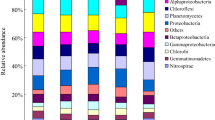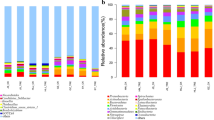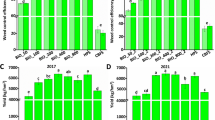Abstract
The bacterial community, biotic factors, and rice yield of Chinese Milkvetch (Astragalus sinicus L.) with no-tillage and conventional chemical fertilizer treatment were evaluated. Analysis of bacterial isolates from each treatment plots with 16S rDNA sequences revealed 486 isolates from 18 different bacterial species. The frequency of spore-forming bacteria, including Bacillus sp. and some Actinomycetes appeared to be high under low temperature conditions, whereas Proteobacteria disappeared at low temperature. Most extracellular hydrolytic enzyme activity showing bacteria belong to low G + C Gram(+) bacteria (LGCGPB) compared to high G + C Gram(−) bacteria (HGCGPB) and Proteobacteria. In addition, the total soil carbon content in Chinese Milkvetch treated soil was higher than that of conventional tilled soil samples. Rice yield was slightly higher in the conventionaltilled field (4.13±0.08 Mg/ha) compared to the Chinese Milkvetch-treated field (3.94±0.15 Mg/ha). However, the field treated with Chinese Milkvetch followed by no-tillage was effective in sustaining LGCGP bacterial species that promote biogeochemical cycling and enrich microbial biomass on paddy soil (3.94±0.15 Mg/ha). These results showed that the Chinese Milkvetch treatment with no-tillage is effective in conserving the soil environment without significant yield loss.
Similar content being viewed by others
References
Alvarez R, Díaz R, Barbero N, Santanatoglia OJ, and Blotta L (1995) Soil organic carbon, microbial biomass and CO2−C production from three tillage systems. Soil Tillage Res 33, 17–28.
Alvarez S and Guerrero MC (2000) Enzymatic activities associated with decomposition of particulate organic matter in two shallow ponds. Soil Biol Biochem 32, 1941–1951.
Anderson JPE and Domsch KH (1978) A physiological method for the quantitative measurement of microbial biomass in soils. Soil Biol Biochem 10, 215–221.
Beyer L, Blume HP, and Peters M (1991) Biological activity and organic matter transformations in typical soils of Schleswig-Holstein. Geoderma 49, 273–284.
Booth MS, Stark JM, and Rastetter E (2005) Controls on nitrogen cycling in terrestrial ecosystems: a synthetic analysis of literature data. Ecol Monogr 75, 139–157.
Bossio DA and Scow KM (1998) Impact of carbon and flooding on soil microbial communities: Phospholipids fatty acid profiles and substrate utilization patterns. Microb Ecol 35, 265–278.
Chander K and Brookes PC (1993) Residual effects of zinc, copper, and nickel in sewage sludge on microbial biomass in a sandy loam. Soil Biol Biochem 25, 1231–1239.
Cho KM, Hong SY, Lee SM, Kim YH, Kahng GG, Lim YP, Kim H, and Yun HD (2007) Endophytic bacterial communities in ginseng and their antifungal activity against pathogens. Microb Ecol 54, 341–351.
Golchin A, Oades JM, Skjemstad JO, and Clarke P (1995) Structural and dynamic properties of soil organic-matter as reflected by 13C natural-abundance, pyrolysis massspectrometry and solid-state 13C NMR-spectroscopy in density fractions of an oxisol under forest and pasture. Australian J Soil Res 33, 59–76.
Huang PM, Wang MK, and Chiu CY (2004) Soil mineralorganic matter-microbe interactions: Impact on biogeochemical processes and biodiversity in soils. Pedobiologia 49, 609–635.
Jenkinson DS and Ladd JN (1981) In Soil Biochemistry, (Vol. 5), Marcel Dekker, New York, NY.
Kandeler E, Tscherko D, and Spiegel H (1999) Long-term monitoring of microbial biomass, N mineralization and enzyme activities of a chernozen under different tillage management. Biol Fertil Soils 28, 343–351.
Keenedy AC and Gewin VL (1997) Soil microbial diversity: Present and future considerations. Soil Sci 162, 607–617.
Kern JS and Johnson MG (1993) Conservation tillage impacts on national soil and atmospheric carbon levels. Soil Sci Soc Am J 57, 200–210.
Lim JM, Jeon CO, Lee GS, Park DJ, Kang UG, Park CY, and Kim CJ (2007) Leeia oryzae gen. nov., sp. isolated from a rice field in Korea. Int J Syst Evol Microbiol 56, 39–44.
Lin L, Qiao YS, Ju ZY, Ma CW, Liu YH, Zhou YH, Zhou YJ, and Dong HS (2009) Isolation and characterization of endophytic Bacillius subtilis jaas ed1 antagonist of eggplant Verticillium Wilt. Biosci Biotechnol Biochem 73, 1489–1493.
Maidak BL, Cole JR, Lilburn TG, Parker Jr, CT, Saxman PR, Stredwick JM, Garrity GM, Li B, Olsen, GJ, Pramanik S, Schmidt TM, and Tiedje JM (2000) The RDP (Ribosomal Database Project) continues. Nucleic Acids Res 28, 173–174.
Moore-Kucera J and Dick RP (2007) PLFA profiling of microbial community structure and seasonal shift in soil of a Douglas-fir chronosequence. Microb Ecol 55, 500–511.
Nannipieri P, Grego S, and Ceccanti B (1990) Ecological significance of the biological activity in soil. Soil Biochem 6, 293–305.
Nelson DW and Sommers LE (1982) Total carbon, organic carbon, and organic matter. In Methods of Soil Analysis, (Part 2). Soil Science Society of America, Inc. and American Society of Agronomy, Inc., Madison, WI.
Ohshiro T, Ohmoto Y, Ono Y, Ohkita R, Miki Y, Kawamoto H, and Izumi Y (2010) Isolation and Characterization of a Novel Fucoidan-Degrading Microorganism. Biosci Biotechnol Biochem 74, 1729–1732.
Perrott KW, Sarathchandra SU, and Dow BW (1992) Seasonal and fertilizer effects on the organic cycle and microbial biomass in a hill country soil under pasture. Australian J Soil Res 30, 383–394.
Preston GM, Studholme DJ, and Caldelari I (2005) Profiling the secretomes of plant pathogenic Proteobacteria. FEMS Microbiol Rev 29, 331–360.
Rattanachomsri U, Kanokratana P, Eurwilaichitr L, Igarashi Y, and Champreda V (2011) Culture-independent phylogenetic analysis of the microbial community in industrial sugarcane bagasse feedstock piles. Biosci Biotechnol Biochem 75, 232–239.
Rey MW, Ramaiya P, Nelson BA, Brody-Karpin SD, Zaretsky EJ, Tang M, Leon ALD, Xiang H, Gusti, V, Clausen IG, Olsen PB, Rasmussen MD, Andersen JT, Jorgensen PL, Larsen TS, Sorokin A, Bolotin A, Lapidus A, Galleron N, Ehrlich SD, and Berka RM (2004) Complete genome sequence of the industrial bacterium Bacillus licheniformis and comparisons with closely related Bacillus species. Genome Biol 5, 1–12.
Saito N and Nei M (1987) The neighbor-joining method a new method for reconstructing phylogenetic trees. Mol Biol Evol 4, 406–425.
Sambrook J and Russell DW (2001) Molecular Cloning: A Laboratory Manual, (3rd ed.), Cold Spring Harbor Laboratory Press, New York, NY.
Tejada M and Gonzalez JL (2006) Relationships between erodibility and erosion in a soil treated with two organic amendments. Soil Till Res 91, 186–198.
Tompson, JD, Higgins DG, and Gibson TJ (1994) CLUSTAL W improving the sensitivity of progressive multiple sequence alignment through sequence weighting, positionspecific gap penalties and weight matrix choice. Nucleic Acids Res 22, 4673–4680.
Waldrop MP, Balser TC, and Firestone MK (2000) Linking microbial community composition to function in a tropical soil. Soil Biol Biochem 32, 1837–1846.
Watanabe K and Hayano K (1993) Distribution and identification of proteolytic Bacillus spp. In paddy field soil under rice cultivation. Can J Microbiol 39, 674–680.
Weber S, Stubner S, and Conrad R (2001) Bacterial population colonizing and degradation rice straw in anoxic paddy soil. Appl Environ Microbiol 67, 1318–1327.
Author information
Authors and Affiliations
Corresponding author
Rights and permissions
About this article
Cite this article
Kim, M.K., Lee, Y.H., Kang, T.H. et al. Influence of Chinese Milkvetch (Astragalus sinicus L.) with no-tillage on soil biotic factors and rice yield. J Korean Soc Appl Biol Chem 54, 899–909 (2011). https://doi.org/10.1007/BF03253178
Received:
Accepted:
Issue Date:
DOI: https://doi.org/10.1007/BF03253178




